nervous coordination
1/30
There's no tags or description
Looks like no tags are added yet.
Name | Mastery | Learn | Test | Matching | Spaced |
|---|
No study sessions yet.
31 Terms
describe the general structure of a motor neuron
cell body, dendrons, axon
what are the additional features of a mylenated motor neuron
schwann cells, myelin sheath, nodes of ranvier
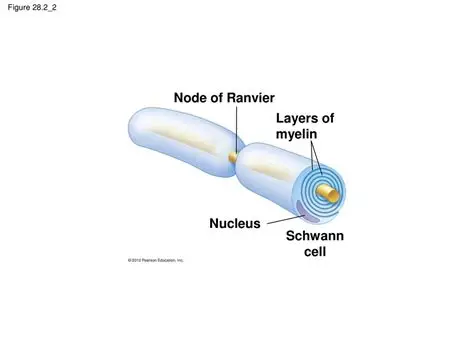
what are schwann cells
wrap around the axon many times
what is the myelin sheath
made from myelin rich membranes of schwann cells. provides mechanical and chemical protection of axon
what are nodes of ranvier
short gaps between schwann cells where there is no myelin sheath- increases nerve impulse transmission speed as impulse jumps from node to node
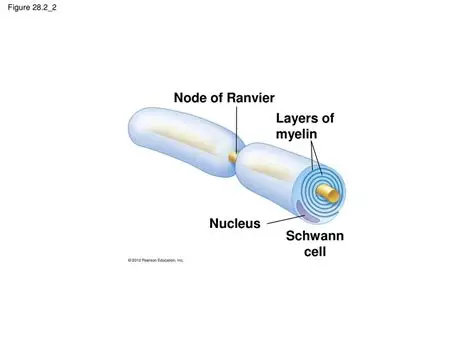
name 3 processes schwann cells are involved in
electrical insulation, phagocytosis, nerve regeneration
what is resting potential?
axon membrane maintained at potential difference of -70mV, ready for nerve impulse
how is resting potential established
membrane more permeable to K+ than to Na+. sodium-potassium pump actively transports 3Na+ out of cell and 2K+ into cell. established electrochemical gradient as cell contents more negative than extracellular environment
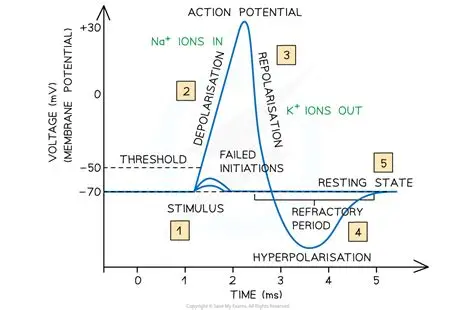
name the stages in generating an action potential
depolarisation, repolarisation, hyperpolarisation, returning to resting potential
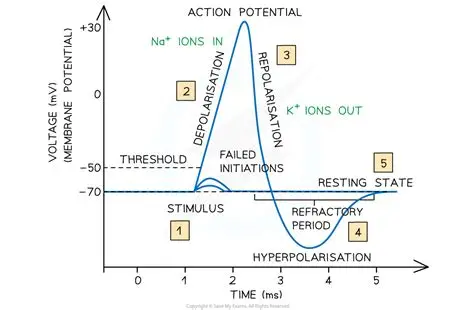
what happens during depolarisation (1st stage of action potential)
stimulus causes facilitated diffusion of Na+ ions into cell, down electrochemical gradient. Na+ channels open. pd across membrane becomes more positive. if membrane reaches threshold potential (-55mV), voltage-gated Na+ channels open. significant influx of Na+ ions reverses p.d to 40mV
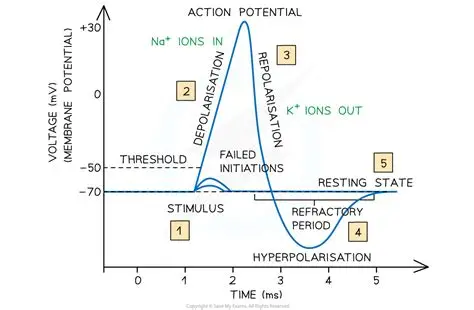
what happens during repolarisation?
voltage gated Na+ channels close and voltage gated K+ channels open. facilitated diffusion of K+ ions out of cell down their electrochemical gradient. pd across membrane becomes more negative
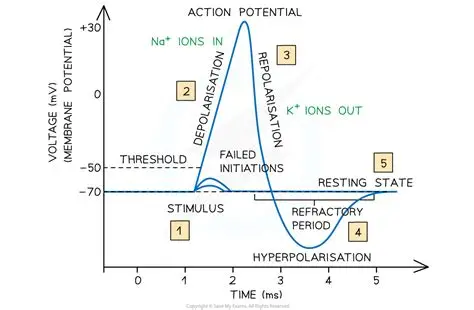
what happens during hyperpolarisation
K+ ions diffuse out and pd becomes more negative than resting potential. refractory period = no stimulus is large enough to raise membrane potential to threshold. voltage gated K+ channels close and sodium-potassium pump re-establishes resting potential
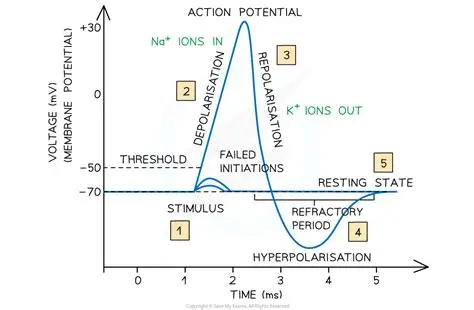
what is the refractory period
time is takes for axon membrane to repolarise and return to -70mV = resting potential.
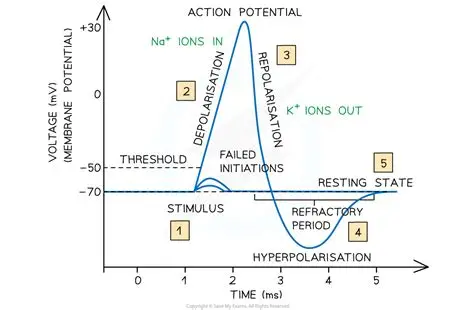
why can’t an action potential take place during a refractory period.
Na+ has not been pumped out of the cell and the K+ has not been pumped in
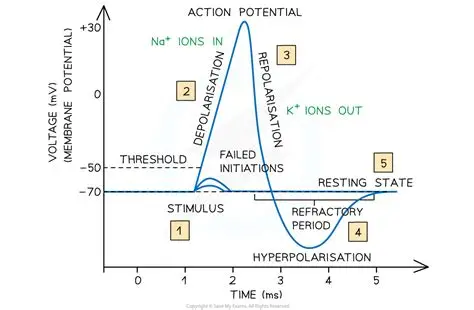
advantages of the refractory period
ensures 1 way travel of nerve impulse, can’t travel backwards if the only open sodium channels are in front of it
produces discrete imoulses- allows nervous system to decipher the strength of the stimulus
limits number of action potentials, and therefore strength of the stimuli that can be detected- protection of CNS
what is the all or nothing principle
any stimulus that causes the membrane to reach threshold potential will generate an action potential (+40mv). small stimuli may cause a small increase in membrane potential
what is the advantage of having a threshold
nervous system would be overloaded if responded to every stimulus, so only larger stimuli result in an impulse
how does the brain detect the size of the stimulus? (3)
the greater the stimulus, the greater the frequency of impulses transmitted along the axon. greater stimuli stimulate more neurones, so more impulses carried to CNS. different neurones have different threshold values so brain can interpret size of stimulus by which neurons are bringing nerve impulses
name the factors that affect the speed of conductance
myelin sheath, axon diameter, temperature
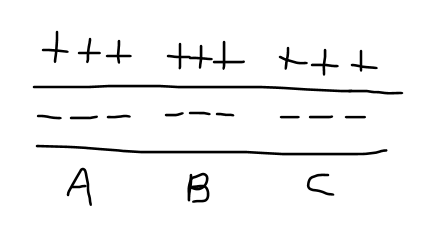
what is happening in this image?
A B C all at resting potential

what is happening in this image?
an action potential at A sets up a local current between A and B
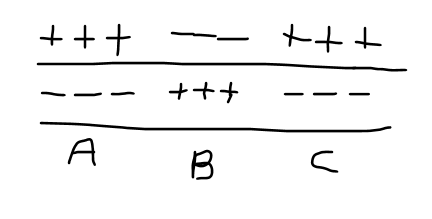
what is happening in this image?
local current between A and B opens Na+ channels, causing action potential at B. this creates a local current between B and C. A is repolarising, B is depolarized (action potential) and C is polarized (resting potential)
at resting potential, is it positive or negative on the inside/outside? what does this mean?
negative inside, positive outside. means its polarized
at resting potential (-70mV) where is the sodium?
all outside of the membrane
during an action potential (+40mV) how are sodium and potassium distributed? what happens to the Na+ channels?
sodium evenly distributed between inside and outside, K+ all inside. Na+ channels shut.
what is neurone excitability?
how likely for an action potential
how does the axon diameter affect the speed of nerve impulse transmission?
thinner axon, greater SA to volume ratio. more ion leakage, harder to maintain resting potential in membrane, impulse transmission is slower.
how does the axon being myelinated/unmyelinated affect the speed of nerve impulse transmission?
myelinated neurones transmit impulses faster due to saltatory conduction from node of ranvier to node of ranvier
how does the temperature affect speed of nerve impulse transmission?
higher temperature, ions diffuse faster so action potential is set up faster. however, at very high temps, membrane proteins (Na and K channels, Na/K pump) denature, which prevents action potentials from being set up
explain the process of transmission across a cholinergic synapse
action potential arrives at the presynaptic cell and causes depolarisation of the membrane. voltage-gated calcium ion channels open. calcium ions diffuse into presynaptic neurone. vesicles containing ACh move towards and fuse with presynaptic membrane, releasing ACh into synaptic cleft. ACh molecules diffuse across the synaptic cleft and bind to receptor proteins in the postsynaptic membrane. these ligund gated sodium channels, allowing sodium ions to diffuse into the postsynaptic neurone. postsynaptic membrane depolarised, and if a threshold is reached then a new action potential is generated in postsynaptic neurone. enzyme acetylcholinesterase catalyses hydrolysis of ACh in synaptic cleft. products of ACh breakdown are absorbed by presynaptic cell, which uses them to produce more ACh
what happens when no more impulses are arriving at the synapse?
as long as ACh is in the synaptic cleft, it will bind to ligund gated sodium channels and sodium will continue to diffuse into the postsynaptic cell causing nerve impulses to be fired. when we want to stop sending messages, acetylcholinesterase hydrolyses ACh into choline and acatate (ethanoate). the choline reenters synaptic knob and used to resynthesise acetyl choline